Channel Islands National Park
Pack your toothbrush and swimsuit, grab your camera, take your Dramamine (if necessary), and join us on multi-day voyage to the Channels Islands National Park, off the coast of southern California.
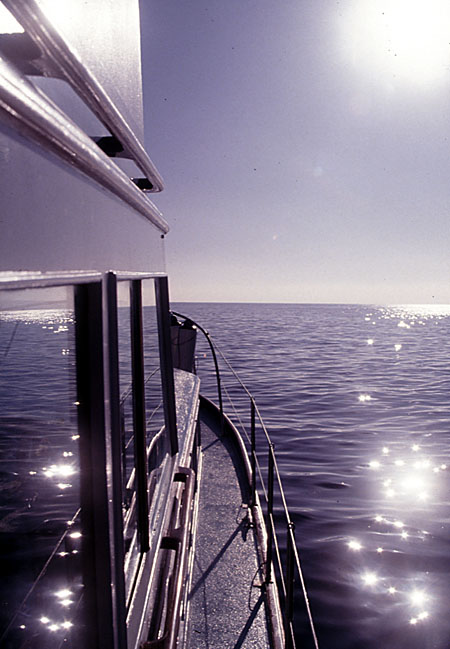
There are eight islands off the coast of southern California. The most famous, and most visited is Catalina Island, home of Avalon harbor. The island of San Nicholas is owned by the U.S. Navy, which maintains a facility on the island, and is off limits for civilian visitation. But there are five primitive, wonderful islands that comprise the Channel Islands National Park. On this voyage, we shall visit the four northern islands of the Park; Anacapa, Santa Cruz, Santa Rosa, and San Miguel Islands. It is not easy to get to San Miguel Island. Located at the far reaches of the Santa Barbara Channel, the weather and sea conditions dictate whether you will be able to reach the island without having to turn back. Although the seas may be mild at times, they will often reach heights of 25-30 feet, accompanied by gale force winds. The area around the northern Channel Islands is no place for novice mariners, but relax, you are in the company of a couple of seasoned veterans.
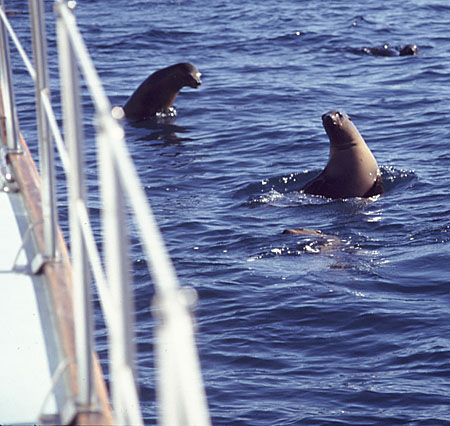
The first island we pass after departing from Channel Islands Harbor is Anacapa Island. A small island hosting a lighthouse and small ranger station, this island is situated about 11 miles from Channel Islands Harbor. We will cruise along the back side of this island, where we might be treated to a visit from curious California Sea Lions, who inhabit the rookery at Anacapa Island for part of the year. After spending a little time with the sea lions, we will continue on our voyage, heading for Santa Cruz Island. Here we will spend the night at anchor at a lovely spot on the back side of the island known as Albert’s Anchorage, about 30 miles from CI Harbor. After a nice dinner prepared on the deck BBQ grill, we relax and watch the sun set on the horizon.
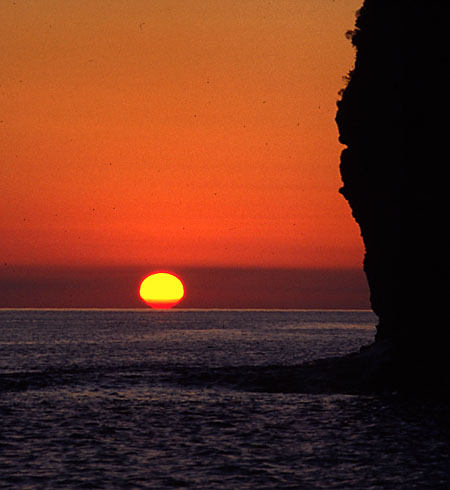
“A red sky at morning, sailors take warning. A red sky at night, a sailor’s delight”. According to this old mariners adage, we should be in for a pleasant days journey on the morrow, as we intend to head on over to the next island in the northern chain – Santa Rosa Island. Santa Rosa Island has an interesting and unique history as a cattle ranch.  Prior to the purchase of the island by the U.S. government for inclusion into the National Park, the island was privately owned and operated as a large and productive cattle ranch.  Mexican vaqueros (cowboys) tended the herds, and the cattle were highly prized for their excellent quality beef. The cattle transport vessel Vaquero, and later, the Vaquero II, was a common sight in the Santa Barbara Channel, as it shuttled the animals to the mainland from the island. After the sale of the island, the ranching operation was permitted to continue for a period of time, after which operations ceased, and the cattle were removed from the island. We intend to cruise to the south side of the island, where we will set our anchor at a spot called Johnson’s Lee, which is about a 60 mile journey from CI Harbor.
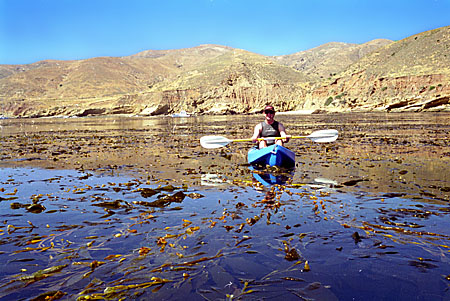
Johnson’s Lee is a (sometimes) protected anchorage that contains abundant kelp (giant macrosistis) in beds to depths up to 100 feet. It is a perfect spot to paddle a kayak, fish, or scuba dive. Most days you will find that the anchorage belongs to you alone. Occasionally, a commercial dive or fishing boat will pass by, but Johnson’s Lee is generally a secluded spot.
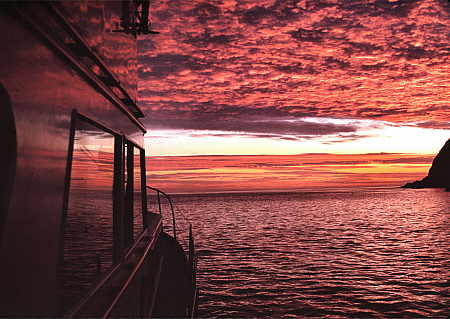
As you can see in the photograph above, we seem to be blessed with red skies each night of this trip, and as we listen to the marine forecast on the VHF radio, it looks as if it will be a “go” for our last leg of the cruise to San Miguel Island in the morning. This final segment of the trip will take us out of the comparative shelter of the islands and expose us to the full force of the prevailing wind, swell and seas of the Pacific Ocean. Our goal is Cuyler Harbor on the northeast side of San Miguel Island. Because we have been lucky with the weather, it turns out to be a pleasant and uneventful day of boating, and eventually we enter into, and drop anchor at Cuyler Harbor.
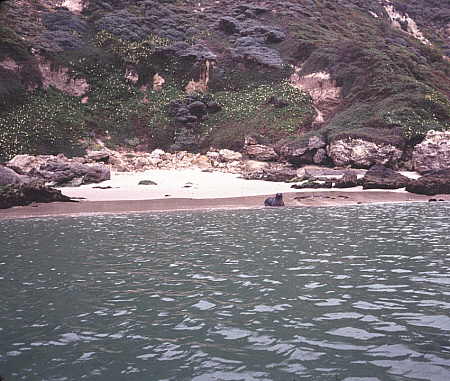
As usual, we are the only vessel in the harbor, although we may be joined by 1 or 2 small fishing boats in the evening, as they tuck in for the night. We may be the only boat in the harbor, but we are not alone. This is the time of the season when the Northern Elephant Seal females, young males, and weaners (weaned pups) haul out for molting along the sandy beaches of Cuyler Harbor.
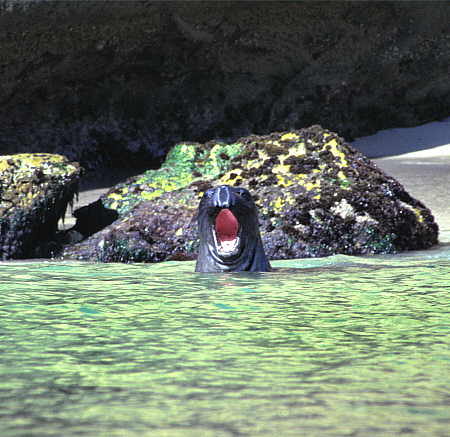
Here, a young male elephant seal practices his guttural bellowing. The low, rumbling sound of his calls can be heard for quite a distance, and provides an interesting diversion to the sounds of the sea lapping against the hull of the boat at night.
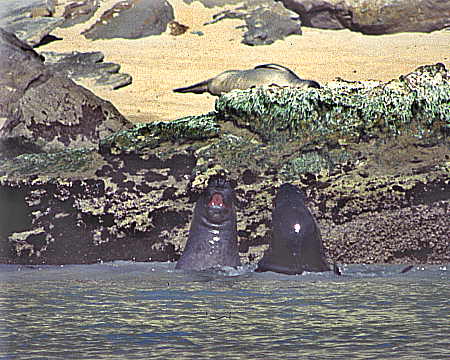
These two young male elephant seals are playfully sparring with each other, practicing for the time when such posturing and bullying will determine mating opportunities with female elephant seals. The games continue for hours at a time, and then the young males will haul themselves up onto the beach for some sunning and sleeping.
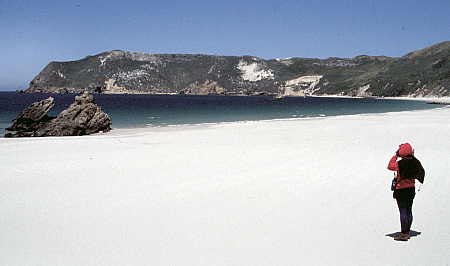
Using the Zodiac tender to land on the beach, we begin our land-based explorations of Cuyler Harbor. The white sand beaches of the harbor are breathtaking, and the sense of remoteness and isolation permeates the air, along with the cool, salty breezes coming off the water.
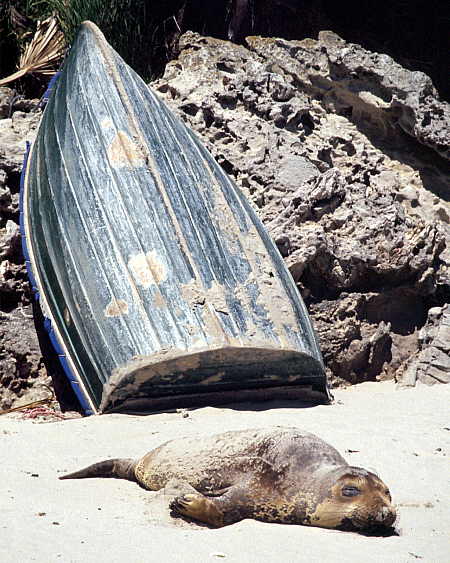
As we begin our hiking, we must pass this weaner, who is quite content to lay on the beach for hours, if not days, on end. Perhaps he is waiting for someone to help him launch his skiff leaning up against the rocks. It must be his, as no one else was to be found on the island, and there were no other boats in the harbor.
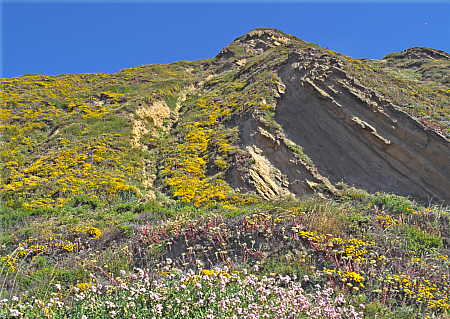
San Miguel Island is one of the few spots in the world that hosts the beautiful Giant Coreopsis. We are lucky to be here at a time of year when they are in bloom, and the hillsides are bright yellow as far as the eye can see. Mixed in among the coreopsis are numerous species of wildflowers, each more beautiful than the next.

Hiking up the overlook trail, we can look back down upon Cuyler Harbor, as we catch sight of our vessel anchored off in the distance. Eventually, our land based explorations come to an end (to be detailed in a future post), and we return to our vessel and bed down for the night. We will spend several more days at anchor here in Cuyler Harbor, paddling kayaks, diving, and hiking on the island. When the weather forecast suggests calm seas in the morning, we secure the vessel for the long cruise back to Channel Islands Harbor. Our return route will take us along the front (weather) side of the northern Channel Islands, but the journey should be just fine, as the forecast is for “fair weather, and following seas”, just the words any mariner longs to hear.
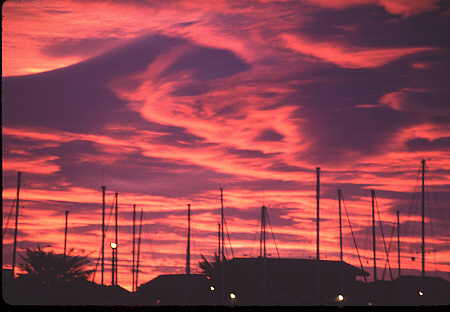
It is evening before we pull into the slip at Channel Islands Harbor, and after securing and washing off the boat, we sit back on our deck chairs to watch another in the fortunate series of evening sunsets before us.  “Look, Retta – a red sky at night. Do you want to head off to San Miguel in the morning?”Â



Wow! Fantastic photos! Thank you for sharing with us. Do you set off to this destination often, or was this a one time trip?
Mrs. S- We have been to San Miguel Island on many occassions, on commercial dive boats, and on the boat that we formerly owned. Retta and I spent nearly two years “swinging on the hook” (anchored) out at the Channel Islands, but that is just a memory now that we are boatless and living in the central part of the U.S. We miss that lifestyle very much, but it is a sacrifice we had to make to do the things we are now doing. It seems all things in life require a tradeoff, doesn’t it?
My high school buddy is currently the superintendent of Channel Islands.
i took a day trip to anacapa island another lifetime ago. thanks for trip down memory lane. btw, this is my first visit to your blog and i have enjoyed myself. i’ll be back
FC – I have had the privilege of working with two gentlemen at Channel Islands NP – Russ Galipeau (Superintendent), and Gary Davis (chief scientist). They are both fine, dedicated men. If Russ Galipeau is your high school buddy, than I would have to say that this reinforces the refrain that “it’s a small world after all.”